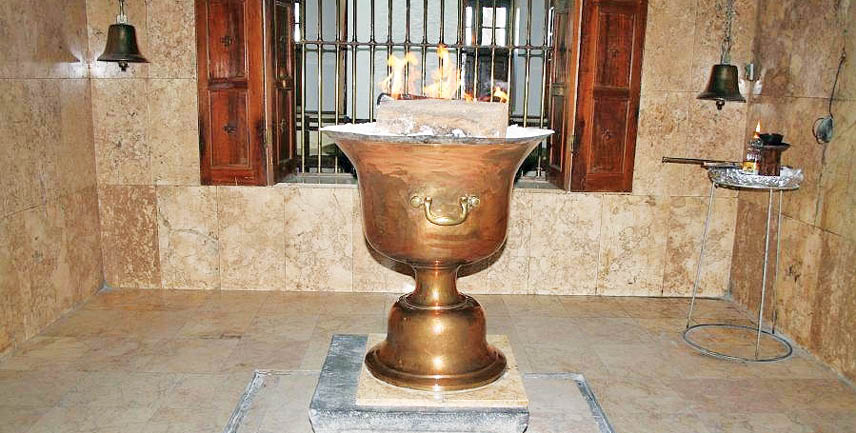.
Myth: Why do we, as a community, waste thousands of rupees year after year on costly firewood, sandalwood, meaningless rituals and prayers to fire instead of praying to Ahura Mazda directly? Are hands that help not holier than the lips that pray? Why can’t monies wasted on maintenance of fire temples be diverted for other purposes? Can we not divert monies wasted on rituals for the poor and needy?
Fact: The fires burning in our Agiaries and Atash Behrams are no ordinary match stick fires. They are consecrated fires (Ijaila Atash) which, doctrinally, are regarded as conscious living entities, worthy of our reverence and worship. This, of course, is without prejudice to the fact that Ahura Mazda is the ultimate Spirit/Divinity we worship through the consecrated fires.
Most religions (Zoroastrianism, Hinduism, Judaism, Christianity or Islam) comprise both the doctrine and the practices of the Faith. In other words, theology as well as ritual practices of the Faith go hand in hand.
Fire is energy with the capacity to animate. When fire energies operating in our body are extinguished, we die and the body grows cold.
Rituals are not “meaningless” as many seem to believe. Rituals may be seen as a process of falling in step with life, as it unfolds within the frames of time and space. Rituals such as the boi ceremony or offering a Nyaish before a consecrated fire give us an understanding of our relationship with both – the material and spiritual worlds. When performed with understanding and feeling, rituals educate as well as lift the spirit. They help us to experience and recognize the harmony that exists between the material and spiritual worlds.
A Zoroastrian also believes ‘consciousness’ as fundamental. He regards matter as derivative from consciousness. Supports scientist Max Planck, “Everything we talk about, everything we regard as existing, postulates consciousness.” There is nothing pagan therefore in a Zarathushti praying before the sun, the moon, the waters, the mountains or fire. Says Prof. Max Muller in his ‘Introduction to the Science of Religion’ (pg.93) “Their (Aryans’) worship is not, as has been so often said, a worship of Nature. But, I should venture to call it a worship of God in nature”. Max Muller’s worship of God in nature really means, for all practical purposes, the worship of Life in nature.
In the words of Byron, “My altars are the mountains and the ocean, earth, air, stars, all that springs for the Great Whole, who hath produced and will receive the soul.”
In offering worship at an Agiary or Atash Behram, one is, in essence, offering worship to Ahura Mazda through Fire.
We begin the Atash Niayesh with the salutation, “Khshnaothra Ahurahe Mazdao Nemase-te, Atarsh Mazdao Ahurahe hudhao mazishta Yazata,” which means, “May there be the propitiation or pleasure of Ahura Mazda! Homage (be) unto thee, O Fire of Hormazd, Bestowing good, the Greatest Yazata.”
We also affirm, “Us-moi uzareshva Ahura, Armaiti tevishim Dasva, Spenishta Mainyu Mazda, Vanghuya zavo ada, Asha hazo emavat vohu, Manangha feseratum,” which means, “O Ahura Mazda, the most beneficent spirit and the bestower of good things in return for prayers! Do thou purify me (i.e., keep me away from wicked deeds), owing to (my) gentleness (or humility) do thou grant me strength, on account of righteousness, bestow upon (me) mighty power (and) on account of (my) good thoughts, grant me supremacy!”
To the Holy Fire itself we express the following sentiments:
“Yasnemcha vahmemcha huberetimcha
Ushta-beretimcha, vanta-beretimcha, afrinami,
Tava Atarsh puthra Ahurahe Mazdao, yesnyo
Ahi vahmyo, yesnyo buyao vahmyo
Nmanahu mashyakanam ushta buyat
Ahmai naire, yase-thwa badha
Frayazaite, aesmo-zasto, baresmo-zasto
Gao-zasto, havano-zasto.”
which means, “O Fire, the purifier (of all things) pertaining to Ahura Mazda! I praise Thy worship, invocation, good health-giving and friendly gift. (O Fire), thou art worthy of worship and invocation, mayest thou be worthy of worship and invocation in the abodes of men! May there be greatness (or happiness) unto that man who shall always worship thee with fuel, Baresman, milk and mortar in hand.”
Fire is not just a giver of light but also a giver of life. It is fire that keeps this Universe going. It is the energy that spins this entire universe. It is to this Divine Energy of Ahura Mazda that we pay homage and in so doing we actually pay homage to Ahura Mazda.
Ardibehest Ameshaspand or Ahura Mazda’s quality/energy of Asha Vahishta (Righteousness/Truth) presides over fire. In other words, by offering prayers and performing rituals with fire, we reaffirm our commitment to truth and righteousness.
Hands that help may be holier than the lips that pray. But the human being who both – helps and prays – is the best of all!
.
- The Feast Of Tirgan - 23 November2024
- Life And Message Of Asho Zarathushtra – II - 16 November2024
- Life And Message Of Asho Zarathushtra –I - 9 November2024

Excellent article. Even though I am a Jain and not a Zoroastrian, I believe humans have practiced rituals for a cause. It could be religious or it could be that certain natural products had positive effects on nature in general and humans in particular. For example, the ritual in most religions to use Indian Sandalwood (Santalum Album) as a firewood, paste, powder or oil could be on account of miraculous healing properties of Indian Sandalwood – both mind and body. However, if you see today, many inferior products are used like African/ Tanzanian (Osyris Lanceolata) which is passed off as Sandalwood but is not Sandalwood or Australian variety Santalum Spicatum (which again is very inferior product) is not in lieu of the Indian Sandalwood which has become expensive and thus the aura of healing mind and body through religious rituals at temples is somewhat missing. Fortunately, most religious institutions have realized that they need to grow Indian Sandalwood trees and have started cultivating Sandalwood in their own backyards.